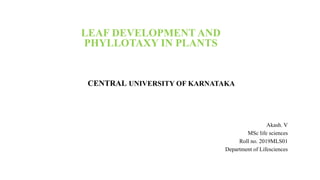
Leaf development in plants by Akash Naara
- 1. LEAF DEVELOPMENT AND PHYLLOTAXY IN PLANTS CENTRAL UNIVERSITY OF KARNATAKA Akash. V MSc life sciences Roll no. 2019MLS01 Department of Lifesciences
- 10. KNOX immunolocalization in maize shoots. A. KNOX proteins accumulate in the SAM but are excluded from leaves and leaf founder cells located in the periphery of the SAM (arrow in A). B. On application of NPA, leaf initiation is arrested and there is no loss of . KNOX accumulation in the SAM like A. KNOX GENE INHIBITION
- 13. miR166 PHB mRNA PHB-1D mRNA In wild-type plants, miR166 binds to the PHB mRNA and degrades it on the abaxial side of the leaf primordium. In phb-1d plants, base changes in the PHB mRNA prevent miR166 from binding to it, allowing it to accumulate throughout the leaf primordium. Control of PHB expression by miRNA
- 17. PHYLLOTAXY Distichous or alternate -- When each node has one organ, and those at adjacent nodes are opposite, as in maize. Decussate -- Two opposite organs at each node that are offset by 90° from those at adjacent nodes. – Coleus. Tricussate- Nerium Spiral -- a single organ at each node, but with 137 degree turn°. Whorled -- used for more than two organs at each node, e.g. flowers- sepal & petals Arrangement of leaves on stem
- 18. Cross section of rice apex Alternate Opposite Whorled
- 19. How primordia develops on Shoot apical meristem? • The apical meristem is a pattern-generating machine. • The WUS/CLV engine (yellow) maintains a supply (arrows) of cellular material to the rest of the meristem (blue) to maintain its size and shape. • At periodic intervals (termed plastochron), meristem tissue becomes determined to form a leaf primordium at a site termed incipient primordium1 (l1; mauve). • The position of l1 is determined by the positions of the previously formed leaf primordia, in this example P1 and P2 (green).
- 20. P3 P2 P1 I1 I2 Two days later, the apex was examined a P3 P2 P1 I1 I2 I1 (shown in black) was surgically isolated from the rest of the meristem, by cutting along the red line. P3 P2 P1 I1 I2 I3 Instead of emerging at its expected position (star), I3 shifted towards I1. This experiment shows that I1 influences I3 position. Positions of I2 and I3; older leaves have been cut away.
- 21. Is there any cross talk between primordia and SAM? A single L1 cell of Betula SAM was injected at the SAM centre with a fluorescent dye Injection into the central zone shows that it is symplastically isolated from the peripheral zone. Dye does not move in PZ Curved arrows show direction of dye movement. Dye moves with in 5 sec.
- 22. Occasionally, some CZ injection showed symplastic connections with discrete domains in the PZ. T The positions of these symplastic connections appeared to be related with position of incipient primordia.
- 23. Wild-type Arabidopsis Shoot apex pin1 shoot apex What is the nature of Signal regulating primordia initiation? Arabidopsis reduced polar auxin transport mutant Pin1 shows pin shaped inflorescence Evidences favors auxin as regulatory molecule
- 24. 38 hours after application 4 days after application Applying a spot of exogenous auxin (shown as a red blob) stimulates outgrowth of primordium in the pin1 mutant.
- 25. What exactly happens in shoot apex? Where exactly auxin moves? A. In apex PIN1 protein was seen in epidermis and vasculature of leaf primordia, also well L1 layer and at lower levels in L2 B. A marked induction at the meristem flank (A) corresponded with the site of incipient and young leaf primordia. C. PIN1 signal in the L1 and L2 layers was consistently localized to the apical side of the cells, that is, pointing to the meristem summit (C, arrowheads), except for the cells close to the site of incipient leaf initiation (I1). In these cells, the signal pointed to I1 (Fig. 1c, arrows). At the summit itself, the signal was more diffuse than at the flank (C).
- 26. The Meristem Marker SHOOTMERISTEMLESS (STM) is downregulated as PIN1 is upregulated at Incipient Primordia • At white arrowheads PIN1 is higher and STM is missing Auxin is trafficked apically through the epidermis and becomes concentrated at a point on the meristem flank that corresponds to the next incipient primordium. • The establishment of this auxin concentration peak is critical to the proper initiation of the primordium. • Auxin is then drained through the center of the primordium
- 27. Auxin accumulation in young primordia. PIN1 is induced in young primordia. It becomes localized to the side of the cells that points to the centre of the primordium (light blue). This results in the accumulation of auxin in the primordium and its withdrawal from the surrounding cells (bluearrows). The resulting auxin gradient (red) confers positional information to the cells allowing them to establish organ and boundary identity. Inset: Location of the P1 position in the context of the apex.
- 28. I1 TIME After primordium initiation, PIN1 distribution changes, directing auxin flow into the developing midvein
- 29. Thank you